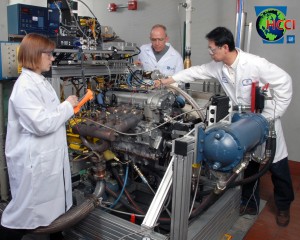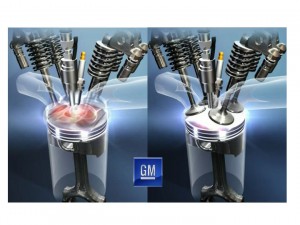
Members of the GM's HCCI team preparing a prototype engine for testing.
The battle between the Otto cycle and the Diesel cycle in auto engines goes back more than 100 years. Diesels have a fuel economy advantage, roughly 20%, compared to traditional gasoline engines largely because of a higher compression ratio needed to ignite the fuel and the elimination of “pumping losses” caused during the intake stroke of a gasoline engine when it is operating at partial throttle.
However, the fuel injection system of a diesel and the heavier components required to hold up to the higher pressures make it much more expensive – these days thousands of dollars more – than a gasoline engine. Tighter emissions laws on cancer-causing particulate matter are adding to the expense and reducing fuel economy. Also, diesel fuel doesn’t ignite as readily as gasoline, which makes cold starting problematic.
As automakers continue the unending quest for greater fuel efficiency, a hybrid combination of diesel and gasoline engines is being studied to see if the best characteristics of both can be obtained.
One such initiative is going on at General Motors where a homogenous charge compression ignition (HCCI) engine is under study. An HCCI engine, when combined with other advanced technologies, can provide up to 15% greater fuel economy than a comparable, non-HCCI engine by using the diesel combustion process.
“HCCI delivers enhanced fuel savings without sacrificing the performance consumers have come to expect,” said Dr. Uwe Grebe, executive director for GM Powertrain Advanced Engineering.

Left: Traditional gasoline combustion. Fuel enters via the intake port and a spark plug ignites the air and fuel mixture. The "burn" of the mixture projects from the spark and the flame progresses throughout the combustion chamber. Right: HCCI combustion. Fuel enters via an injector in the combustion chamber. The air and fuel mixture ignites through heat caused by compression and without a spark. The lower temperature "burn" of the mixture is simultaneous and even throughout the combustion chamber.
Grebe explains that the heat and pressure within an HCCI engine’s cylinders are used to ignite the air/fuel mixture without the aid of a traditional spark-generated flame. Heat is needed for the HCCI process, though, so traditional spark ignition is used when the engine is cold to generate heat within the cylinders and instigate “auto-ignition” of the mixture. Diesel engines typically use glow plugs to warm the fuel when the engine is cold.
GM claims that HCCI has been successfully demonstrated in prototype models in North America and Europe. Last spring, GM took the technology on the road, putting journalists and others in an HCCI-equipped Saturn Aura for real-world drives in Los Angeles, Washington, D.C., and New York. That prototype vehicle employed auto-ignition (HCCI) from idle to 60 mph, which GM says significantly advances the benefits of HCCI and its ultimate viability for production.
The increase in the HCCI operating range of the prototype vehicle is the result of a patented mixed-mode calibration that includes “pre-reacting fuel and exhaust gas” in the cylinder to bolster the pressure and heat needed for auto-ignition.
HCCI’s efficiency comes from reduced pumping losses, burning fuel faster at lower temperatures and reducing the heat energy lost during the combustion process. GM claims the engine now approaches a diesel’s efficiency. Less carbon dioxide is released because the engine’s operation in HCCI mode is more efficient. Unlike a diesel, it requires only a conventional exhaust system. Diesel engines require more elaborate and more expensive exhaust “after treatment” to reduce emissions.
This nascent engine is not without its challenges, though, including the ever increasing efficiency of traditional gasoline engines. Then there’s the simple Newtonian challenge of F=MA. The Force required to Accelerate a Mass is directly proportional to how heavy the vehicle is. By reducing the weight of a vehicle and downsizing all of its components, including the engine, huge fuel economy gains can be obtained. In fact, the core strategies of many automakers going forward rely on huge weight losses — 750 to 1,500 pounds per vehicle, and down-sized, forced induction engines.
Dr. Grebe says his biggest problem is the control of the combustion process over the wide range of operating conditions experienced in everyday driving because, unlike a conventional-ignition engine, HCCI’s combustion is not controlled by a precisely timed computer-calculated spark. Ensuring auto ignition at extreme temperatures and in the thinner air of high altitudes are also challenges. So development work goes on.
We would also add one other challenge the list: GM doesn’t have a good record of innovating and successfully bringing new technology to market ahead of its competitors.
